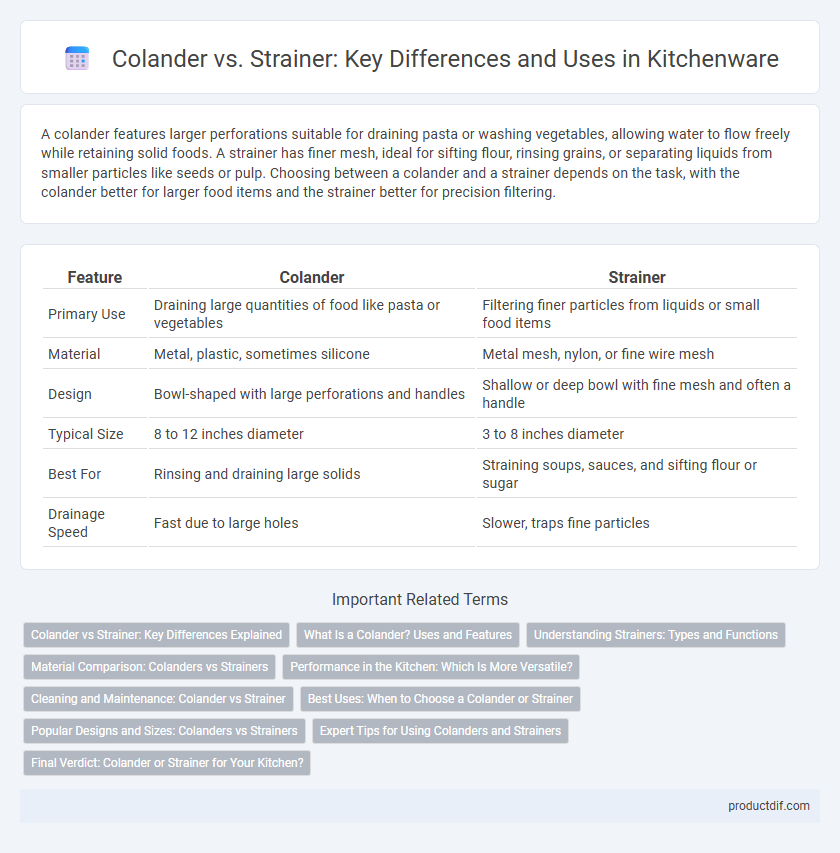A colander features larger perforations suitable for draining pasta or washing vegetables, allowing water to flow freely while retaining solid foods. A strainer has finer mesh, ideal for sifting flour, rinsing grains, or separating liquids from smaller particles like seeds or pulp. Choosing between a colander and a strainer depends on the task, with the colander better for larger food items and the strainer better for precision filtering.
Table of Comparison
| Feature | Colander | Strainer |
|---|---|---|
| Primary Use | Draining large quantities of food like pasta or vegetables | Filtering finer particles from liquids or small food items |
| Material | Metal, plastic, sometimes silicone | Metal mesh, nylon, or fine wire mesh |
| Design | Bowl-shaped with large perforations and handles | Shallow or deep bowl with fine mesh and often a handle |
| Typical Size | 8 to 12 inches diameter | 3 to 8 inches diameter |
| Best For | Rinsing and draining large solids | Straining soups, sauces, and sifting flour or sugar |
| Drainage Speed | Fast due to large holes | Slower, traps fine particles |
Colander vs Strainer: Key Differences Explained
Colanders are typically bowl-shaped kitchen tools with larger holes designed for draining pasta and rinsing vegetables, offering quick water flow. Strainers feature a fine mesh or perforated surface ideal for sifting flour, catching seeds, or filtering liquids to remove smaller particles. Understanding these differences helps choose the right tool for tasks like draining versus fine filtering in food preparation.
What Is a Colander? Uses and Features
A colander is a kitchenware tool designed with large perforations to quickly drain water from foods like pasta, vegetables, and fruits. Typically made from stainless steel, plastic, or silicone, it features a bowl shape with handles for easy handling and durability for frequent use in boiling and rinsing tasks. Unlike strainers, colanders are ideal for larger food items and high-volume draining due to their size and drainage efficiency.
Understanding Strainers: Types and Functions
Strainers come in various types, including mesh strainers, fine-mesh sieves, and chinois, each designed to filter different food textures and particle sizes. Mesh strainers are ideal for rinsing fruits or draining pasta, while fine-mesh sieves excel at sifting flour or removing seeds from sauces. Chinois strainers feature a conical shape for achieving ultra-smooth textures in soups and custards, emphasizing their specialized function in the kitchen.
Material Comparison: Colanders vs Strainers
Colanders are typically made from stainless steel, plastic, or silicone, offering durability and resistance to rust and heat, ideal for draining large quantities of pasta or vegetables. Strainers commonly feature fine mesh made from stainless steel or nylon, designed for fine sifting or separating small particles from liquids, making them essential for tasks like sifting flour or rinsing grains. The choice between colanders and strainers hinges on the material's sturdiness and mesh fineness, affecting their efficiency in kitchen drainage and filtration tasks.
Performance in the Kitchen: Which Is More Versatile?
Colanders excel at draining large quantities of pasta or rinsing vegetables due to their wide, bowl-like shape and larger perforations, making them ideal for quick, bulk tasks. Strainers, featuring finer mesh and smaller size, offer precision filtering for tasks like sifting flour, separating seeds, or straining liquids, adding versatility in more delicate kitchen processes. Choosing between a colander and strainer depends on whether you prioritize handling substantial volumes or require finer filtration for detailed culinary preparations.
Cleaning and Maintenance: Colander vs Strainer
Colanders with larger holes are easier to clean since food particles rarely get stuck, while strainers with fine mesh require thorough rinsing and occasional scrubbing to prevent clogging. Stainless steel models in both categories resist rust and dishwasher safe features simplify maintenance. Regular inspection of strainer mesh is essential to ensure longevity and hygiene, whereas colanders generally demand less detailed upkeep.
Best Uses: When to Choose a Colander or Strainer
Colanders are ideal for draining large quantities of pasta, washing fruits and vegetables, or rinsing salads due to their wide, bowl-like shape and larger perforations. Strainers excel at sifting fine particles, straining sauces, or separating solids from liquids in smaller quantities because of their fine mesh design. Choosing between a colander and a strainer depends on the task's volume and the size of particles needing separation in kitchenware applications.
Popular Designs and Sizes: Colanders vs Strainers
Colanders commonly feature bowl-shaped designs with larger perforations, typically ranging from 8 to 12 inches in diameter, ideal for rinsing fruits, vegetables, and draining pasta. Strainers often come in smaller sizes, around 3 to 6 inches, with fine mesh or perforations suited for sifting flour, straining liquids, or removing seeds and pulp. Popular colander materials include stainless steel and silicone, while strainers frequently utilize fine stainless steel mesh or nylon for precision filtering.
Expert Tips for Using Colanders and Strainers
For optimal use of colanders and strainers, select a colander with larger perforations for draining pasta and vegetables, while strainers with finer mesh excel at rinsing grains and sifting dry ingredients. Ensure the colander's base is sturdy to prevent tipping during use, and choose strainers with comfortable, heat-resistant handles for safe handling. Regularly clean both tools thoroughly to avoid residue buildup that can affect performance and hygiene.
Final Verdict: Colander or Strainer for Your Kitchen?
Choosing between a colander and a strainer depends on your kitchen tasks: a colander's large perforations make it ideal for draining pasta and washing vegetables, while a strainer's fine mesh excels at sifting dry ingredients and straining sauces. For versatile use, many kitchens benefit from owning both tools to handle a variety of cooking processes efficiently. Investing in high-quality materials like stainless steel enhances durability and ensures safer food preparation.
Colander vs Strainer Infographic

 productdif.com
productdif.com